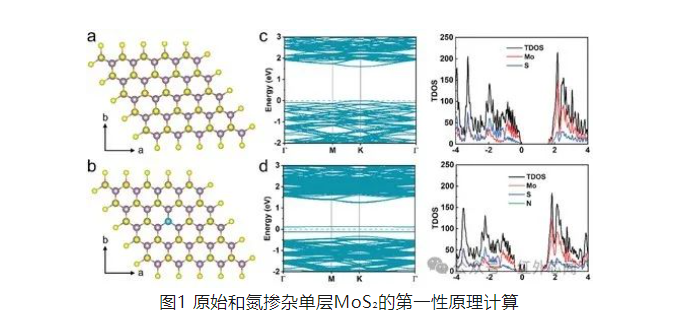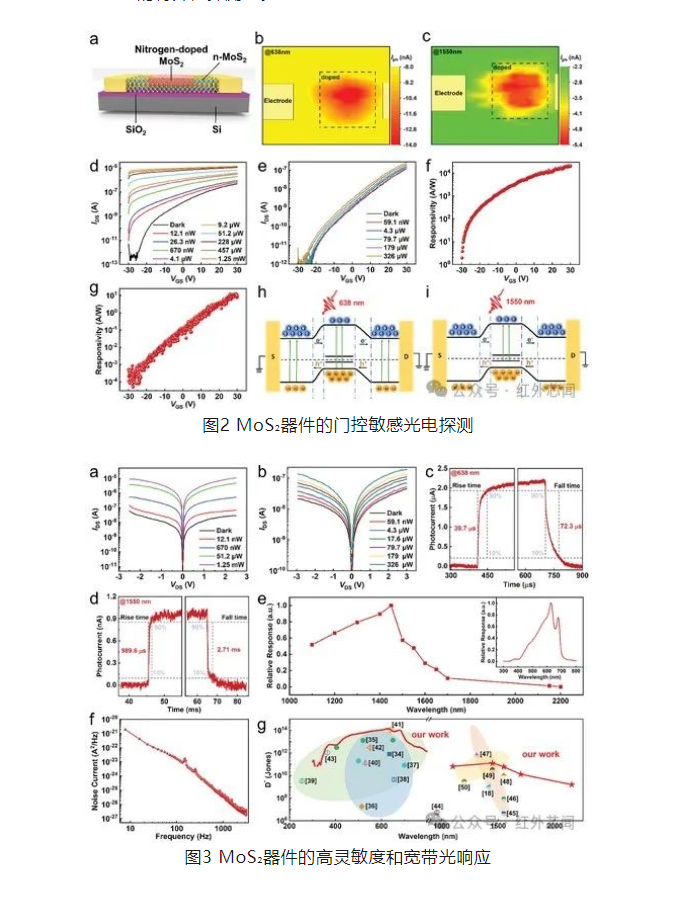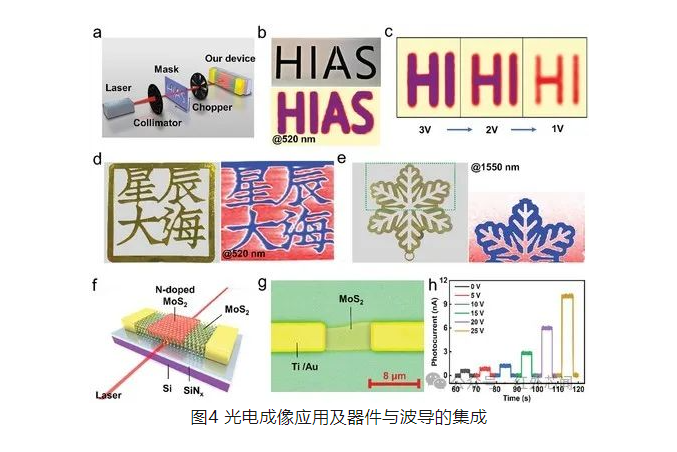01
2024
-
11
Ultra-sensitive wide-spectrum MoS₂ shortwave infrared photoelectric detector
Author:
Two-dimensional materials such as graphene, transition metal chalcogenides and black phosphorus have attracted much attention in the field of optoelectronics due to their unique structure, excellent photoelectric properties and flexibility of regulation. However, most MoS₂ photodetectors only respond to visible light and have limited absorption, resulting in problems of narrow spectral response range and low sensitivity. Existing methods to broaden the spectral response of two-dimensional materials have challenges such as poor performance or difficulty in achieving high concentration external states and high carrier mobility at the same time.
Recently, a scientific research team composed of the University of Chinese Academy of Sciences, Hangzhou Institute of Advanced Studies of the University of Chinese Academy of Sciences and Shanghai Institute of Technical Physics of the Chinese Academy of Sciences has proposed an ultra-sensitive and wide-spectrum MoS photoelectric detector, according to Maims Consulting. The detector achieves efficient photogenerated carrier separation and transport by local p-type nitrogen plasma doping on the n-type MoS₂ surface while retaining the high mobility underlying band gap. The detector exhibits excellent performance in both visible and short-wave infrared bands. The relevant research results are entitled "An Ultrasensitive and Broad-Spectrum MoS2 Photodetector with Extrinsic Response Using Around Homojunction" and are published inAdvanced ScienceJournal.
The researchers prepared MoS nanosheets by mechanical stripping method, and locally doped the n-type MoS surface by nitrogen plasma surface doping technology to form a p-type region and construct a surrounding homojunction structure. Density functional theory (DFT) calculations are used to gain a deeper understanding of the effect of nitrogen incorporation into the lattice, and the relevant results are shown in Figure 1. DFT calculations show that nitrogen doping makes the band gap of MoS₂ slightly reduced, forming two additional energy bands at the top of the valence band, the Fermi level is located between the two energy bands, showing a p-type doping effect, and the formation of impurity energy bands extends the response wavelength to the short-wave infrared band. The researchers also used atomic force microscopy (AFM), X-ray photoelectron spectroscopy (XPS) and ultraviolet-visible spectroscopy to characterize the thickness, chemical valence and photoelectric properties of the materials.

The researchers designed p-n homojunction devices by applying nitrogen doping to the native n-type MoS₂ bandgap. The MoS₂ device design includes a doped p-type region that is semi-enclosed by the original n-type region. The photodetection performance of the device is shown in Figures 2 and 3. The establishment of p-n homojunction promotes the effective separation of photogenerated carriers, thereby improving the intrinsic detection performance of the device. Under 638 nm illumination, the photoresponsiveness of the device is 6.94 × 10 ¹ A W, the specific detection degree is 1.21 × 10 ¹ ¹ Jones, and the optical switching ratio reaches about 10 and. In addition, the introduction of an additional band in the MoS₂ band gap by nitrogen doping achieves an extrinsic broadband response to shortwave infrared. At 1550 nm, the device exhibits an photoresponsiveness of 34 A W. ¹ and a specific detectability of up to 5.92 × 10 ¹ ¹ Jones.

Finally, the researchers conducted optical imaging experiments to evaluate the performance of the photodetector in various imaging applications, as shown in Figure 4. 4a shows the components of the imaging system, including a laser, a collimator, a mask, a chopper, and a photodetector. Optical imaging experiments show that the detector can achieve high-resolution imaging in both visible and short-wave infrared bands, and can accurately image simple and complex objects. The detector is integrated into the silicon nitride planar waveguide, and the waveguide response is successfully realized and can be controlled by the gate voltage, which provides the potential for the application of the next generation of photonic chips.

In summary, a high-quality peripheral homojunction MoS₂ device was successfully prepared by nitrogen plasma injection. The device exhibits excellent photoelectric properties in both visible and short-wave infrared bands. This external response MoS₂ photodetector provides a new way for the infrared detection of low-dimensional materials and the development of high-performance photonic chips and multifunctional imaging devices.
LATEST NEWS
2024-10-05
Calculation of the diffracted light field: Regarding Fresnel near-field diffraction, how should the field distribution be calculated after a plane wave encounters a metasurface and experiences a phase jump?
Previously, a friend wanted to see the source code for the article 'Matlab Optical Fresnel Diffraction, Dynamic Visualization of Matlab Curves and Graphics', and the source code is included in this article.
2024-11-15
Academician Chang Ruihua's team has made new progress in short-distance optical communication high-speed interconnection technology.
850nm wavelength multimode vertical-cavity surface-emitting lasers (VCSELs) and multimode fibers (MMFs) have become the ideal choice for short-distance optical interconnects in data centers and supercomputing systems due to their low power consumption and cost-effectiveness.
2024-11-18
Wide spectrum heterojunction self-powered photodetector with linear and circular polarization detection capabilities
Two-dimensional (2D) materials have become a hot research topic due to their unique mechanical, optical and physical properties such as broadband response range, layer-dependent band gap, tunable electronic and optical properties, and high carrier mobility.
2024-11-07
Spin-based Schrodinger Cat States Prepared by Laser Cold Atom Method
The spin-based Schrodinger cat state is prepared by laser cold atom method, and its lifetime reaches the order of minutes, which helps to improve the measurement sensitivity of spin precession phase.

